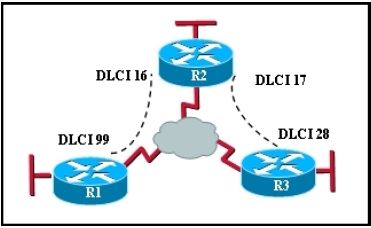What are the three things that the Netflow uses to consider the traffic to be in a same flow? (Choose three)
A. IP address
B. Interface name
C. Port numbers
D. L3 protocol type
E. MAC address
What are the three things that the Netflow uses to consider the traffic to be in a same flow? (Choose three)
A. IP address
B. Interface name
C. Port numbers
D. L3 protocol type
E. MAC address
The output of the show frame-relay pvc command shows “PVC STATUS = INACTIVE”. What does this mean?
A. The PVC is configured correctly and is operating normally, but no data packets have been detected for more than five minutes.
B. The PVC is configured correctly, is operating normally, and is no longer actively seeking the address of the remote router.
C. The PVC is configured correctly, is operating normally, and is waiting for interesting traffic to trigger a call to the remote router.
D. The PVC is configured correctly on the local switch, but there is a problem on the remote end of the PVC.
E. The PVC is not configured on the local switch.
DRAG DROP
Drag the Frame Relay acronym on the left to match its definition on the right. (Not all acronyms are used.)
Select and Place:

Refer to the exhibit.

In the Frame Relay network, which IP addresses would be assigned to the interfaces with point-to-point PVCs?
A.
DLCI 16: 192.168.10.1 /24
DLCI 17: 192.168.10.1 /24
DLCI 99: 192.168.10.2 /24
DLCI 28: 192.168.10.3 /24
B.
DLCI 16: 192.168.10.1 /24
DLCI 17: 192.168.11.1 /24
DLCI 99: 192.168.12.1 /24
DLCI 28: 192.168.13.1 /24
C.
DLCI 16: 192.168.10.1 /24
DLCI 17: 192.168.11.1 /24
DLCI 99: 192.168.10.2 /24
DLCI 28: 192.168.11.2 /24
D.
DLCI 16: 192.168.10.1 /24
DLCI 17: 192.168.10.2 /24
DLCI 99: 192.168.10.3 /24
DLCI 28: 192.168.10.4 /24
Which command is used to enable CHAP authentication, with PAP as the fallback method, on a serial interface?
CHAP authentication
A. Router(config-if)# ppp authentication chap fallback ppp
B. Router(config-if)# ppp authentication chap pap
C. Router(config-if)# authentication ppp chap fallback ppp
D. Router(config-if)# authentication ppp chap pap
Which protocol is an open standard protocol framework that is commonly used in VPNs, to provide secure end-to-end communications?
A. RSA
B. L2TP
C. IPsec
D. PPTP
At which layer of the OSI model does PPP perform?
A. Layer 2
B. Layer 3
C. Layer 4
D. Layer 5
The command frame-relay map ip 10.121.16.8 102 broadcast was entered on the router. Which of the following statements is true concerning this command?
A. This command should be executed from the global configuration mode.
B. The IP address 10.121.16.8 is the local router port used to forward data.
C. 102 is the remote DLCI that will receive the information.
D. This command is required for all Frame Relay configurations.
E. The broadcast option allows packets, such as RIP updates, to be forwarded across the PVC.
Which two options are valid WAN connectivity methods? (Choose two.)
A. PPP
B. WAP
C. DSL
D. L2TPv3
E. Ethernet
Which Layer 2 protocol encapsulation type supports synchronous and asynchronous circuits and has built-in security mechanisms?
A. HDLC
B. PPP
C. X.25
D. Frame Relay